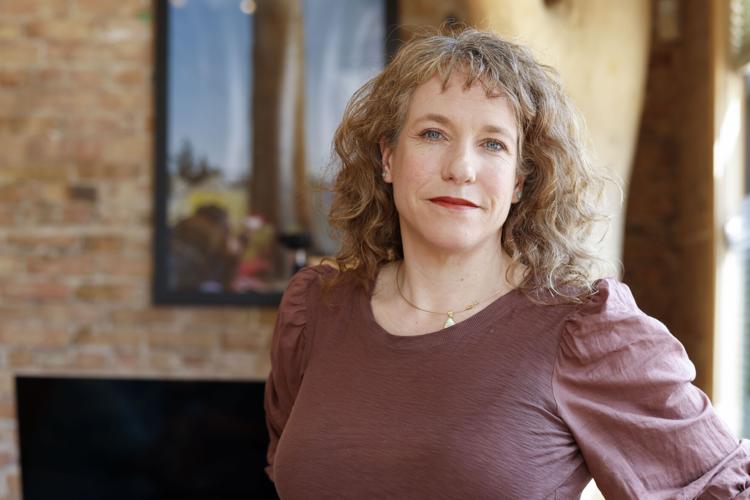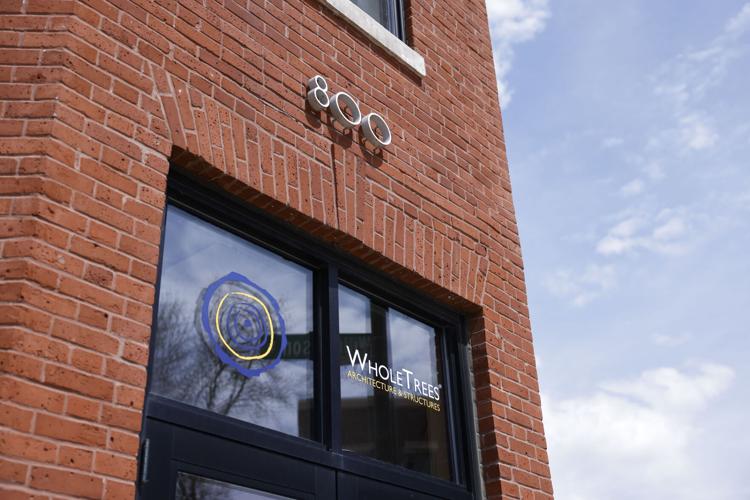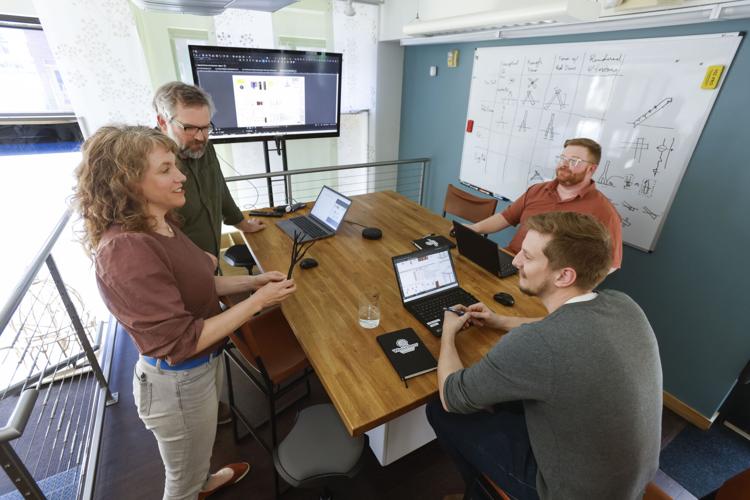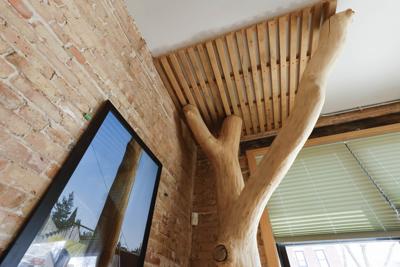When Amelia Swan Baxter started a Wisconsin construction firm specializing in the use of naturally round trees rather than neatly cut lumber, she spent a lot of time convincing potential clients of her product’s viability on a large scale.
“There's a perception that there's no way you could get it done well,” said Baxter, co-founder and CEO of WholeTrees Structures. “What we're trying to do is demonstrate the method of getting (it) back in the market.”
Now the company’s beams and tresses made from round trees — known as Structural Round Timber — are featured across the country, including at Madison’s Festival Foods grocery store and the downtown children’s museum.
Nearly 20 years since launching and a decade since its first national product line, WholeTrees has grown to operating in more than a dozen states and is eyeing further expansion nationwide from its Madison headquarters.
Baxter and architect Roald Gundersen founded the company in 2007 in the rural town of Hamburg, about 10 miles from La Crosse. WholeTrees moved to Madison five years later after receiving grant funding to work with the federal Forest Products Laboratory.
WholeTrees provided Structural Round Timber in residential construction before expanding to commercial spaces. Baxter and her team figured out how to make round trees conform to construction industry grading standards — a vital step that allowed the company to dramatically scale up its operation.
Despite its non-uniform appearance, Structural Round Timber is stronger in many ways than milled lumber, Baxter said. Trees evolved to bear the weight of heavy branches and strong wind gusts. When trees are sawed down, the fibers that built sturdy trunks are cut, too.
“It's also like a rope. If you put all these fibers together into a rope you can pull on, it's very strong. If you cut the edges off of that rope, you then lose a great deal of strength of that rope — same with the tree,” Baxter said. “So in one sense, trees are this brilliant, engineered material all on their own, resisting their own loads.”

Amelia Baxter is the co-founder and CEO of WholeTrees Structures.
Much of the company’s early years focused on convincing potential clients that Structural Round Timber could build large, complex structures. Beyond the appearance, companies were hesitant to rely on a material without knowing it could be used on a large scale.
But Baxter argued Structural Round Timber stands out in energy efficiency compared to other common materials like steel and concrete, which require large amounts of energy to mine, batch and transport.
WholeTrees controls most of the process to select trees for harvest, design structures and grade timber. Harvesting trees from sustainable forests allows for greater carbon sequestration, as trees are replaced and foresters avoid overharvesting.
“It's a very green, smart structural system, and that enables us to sell it at price points equal to other options while still making good profit,” said Baxter, who grew up in Connecticut and studied environmental studies and theology at the University of Chicago.
One of WholeTrees’ first tests was building the Festival Foods on East Washington Avenue. Completed in 2015, the 57,000-square-foot grocery store was built with trusses and columns of local ash trees, Baxter said. The project served as a “showcase piece” to prove that Structural Round Timber could support large commercial buildings.
“It was all very innovative, exciting, and it helped us build credibility with our markets nationwide. It was a big deal,” she said. “Madison holds some of our best work and some of our most complex work.”

WholeTrees Structures' downtown offices are at 800 Williamson St.
WholeTrees branched out to other parts of the Midwest with its first national product line in 2014 and later partnered with tree harvesters in the Pacific Northwest. It has also built playgrounds, pavilions, community centers and solar car ports.
The company recently completed construction of a two-story children’s museum in Eau Claire and began work on a student center in Michigan. Last year, WholeTrees embarked on its biggest expansion — a fabrication facility in Maine, which opened in March 2024 and employs 11 workers. Most of the company’s 40 employees work at either its Madison headquarters or other Wisconsin locations.
Gundersen, the co-founder, left WholeTrees’ leadership about a decade ago. He now runs his own architecture firm but still collaborates with WholeTrees.
Despite ambitious goals, WholeTrees’s expansion has been cautious and calculated, Baxter said. She refuses to greenlight new facilities or projects without ensuring the company can afford to invest by raising equity or receiving grants.
In the beginning, grants kept the company afloat. Now, the company is raising another round of equity — selling shares to fund its future projects. Baxter expects the new Maine facility to become profitable in three years.
“I suppose it's slow (growth) compared to certain companies, but we're doing something no one's ever done in modern construction. No one has thought about this material as a viable structural material,” Baxter said. “So in that sense, I'm kind of proud of how fast we've gone.
“We've been on a rafting trip through rapids, just constantly teaching ourselves the next thing by going through the next set.”

WholeTrees Structures co-founder and CEO Amelia Baxter, left, meets with staff at the company's offices on Williamson Street in Madison.
The Four Questions
What are the one or two most important values driving your work?
Gratitude and awe. I think when we enter a day with gratitude, we are more pleasant to each other and ourselves. I think teams work together better when people are in a place of gratitude as opposed to entitlement, and awe is also kind of a state of curiosity. I'd say a state of curiosity would be the value, and awe is a word we have in our brand.
How are you creating the kind of community you want to live in?
By expanding a value-based company so there's more jobs in the community that can enjoy working in a value-based company, and also providing play structures and awe inspiring structures that our community can walk past and interact with and ignite a sense of awe.
What advice do you have for other would-be entrepreneurs?
Pair your dream alongside rigorous milestones and tracking. They don't hinder the dream, but they inform it and create a skeleton for it to launch off.
Are you hiring?
Yes.
Editor's note: This article has been updated to correct the birthplace of Amelia Swan Baxter, the current work of Roald Gundersen, the status of a Michigan project and details of the company's history.





